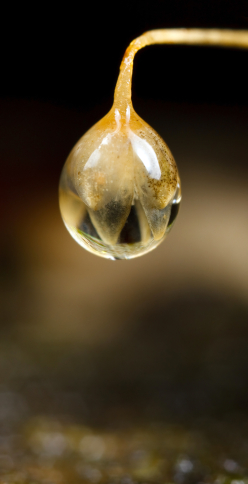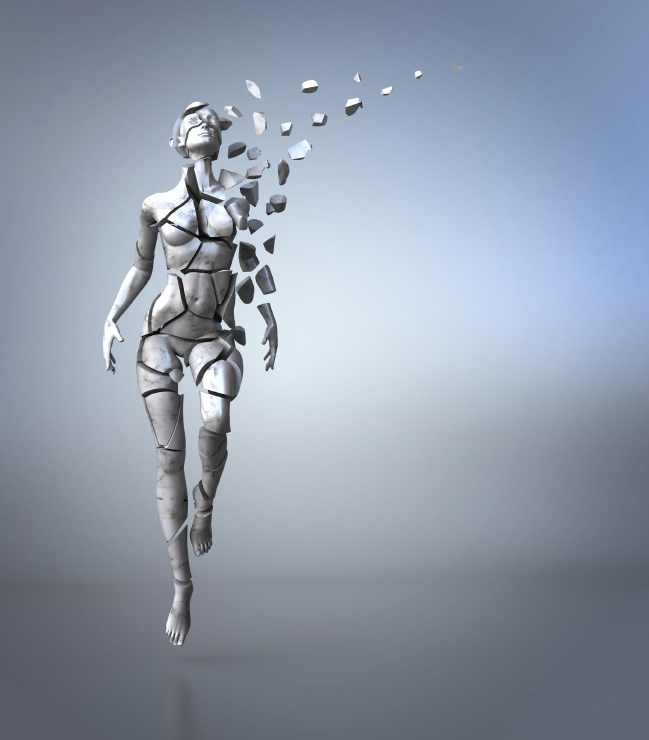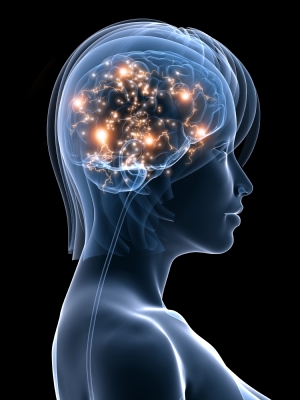Wednesday Bubble: Soy takes a hit (again). But what about S-equol?
Soy is back in the news again, with newly published data suggesting that isoflavones may not be particularly effective when it comes to menopausal symptoms. But I can’t stress enough on this blog that sources are as important as substance; in other words, not all sources are equal and neither are the women who use these alternatives.
So, let’s talk again about S-equol. But first, a bit of context is needed.
We know that soy isoflavones, primarily genistein, daidzein and glycitein have been suggested as an effective strategy for combating menopausal symptoms such as hot flashes or night sweats. The beneficial effects of soy are believed to be associated with the ability to soy isoflavones to attach themselves to estrogen receptors. Importantly, our brains contain certain estrogen receptors in hippocampus, which is responsible for consolidating both short and long-term memory and spatial navigation. Moreover, both genistein and daidzein have been shown to have a particular affinity for the very type of estrogen receptors that reside in the hippocampus, which is why researchers have been so interested in determining if ingesting soy can help combat the natural decline in memory and cognition. While findings have been mixed, some women appear to be better metabolizers of S-equol, a metabolite of a major soy isoflavone called daidzein. It has a particular affinity for estrogen receptors and possesses some estrogen-type activity of its own. S-equol is produced in the GI tract however the ability to actually manufacture it depends on the presence of certain microflora. Consequently, only 30% to 60% of individuals are actually able to produce S-equol on their own (although this figure is believed to be higher among Asians and vegetarians).
I’ve been writing about S-equol for a number of years and you can revisit those posts here. Interest in S-equol is in part, related to its potential for augmenting the benefits of isoflavones; in fact, it is possible that women who are naturally producers of S-equol actually experience greater effects from soy products, and this is especially true when it comes to bone health. Hence, vasomotor symptoms — night sweats and hot flashes — aside, you may not want to give up on soy just yet.
So let’s talk bone health. It’s so critical as we age.Declining levels of estrogen are a primary cause of bone loss and resulting osteoporosis in women; indeed, one in five American women over the age of 50 have osteoporosis and about half will experience a fracture in the hip, wrist or spine as a result. What’s more, because osteoporosis is silent in its early stages, causing no symptoms, it’s critical that bone loss is halted or at least slowed either before or during the most critical phases strike. There is no time like the present to take preventive measures, even if you are in your 30s and 40s.
Where does S-equol fit in?
Last year, researchers demonstrated the daily S-equol supplements taken by women who are not naturally producers of S-equol, may improve bone metabolism and attenuate bone loss. And I reprinting this information because it’s too early for a soy verdict.
In this 1 year study of 356 healthy, postmenopausal Japanese women between the ages of 41 and 62, daily intake of 10 mg S-equol via supplement markedly reduced markers of bone resorption in blood and urine compared to women taking placebo pills or 2 mg or 6 mg of S-equol daily. In fact, in women taking the 10 mg dose for a year, declines in a urinary marker of bone resorption (i.e. DPD) were roughly 21% greater compared to placebo. Measures of whole body bone mineral density also showed that S-equol supplementation protected against bone loss, although not to the extent as bone resorption. These results remained even after changes in height, weight, body mass index, lean and fat mass were accounted for. No participant experienced serious side effects from taking S-equol and hormone levels were not adversely affected.
Does this mean that you should rush out and purchase S-equol supplements?
One of the primary limitations of this study is that the process of bone recycling can take as long as 18 months and the time required to complete a cycle may actually increase with age. Thus, the duration of time that the women were studied might be too short to draw any definitive conclusions. Hence, you may want to wait before you start taking S-equol. However, the evidence that’s building continues to put the weight on the benefits versus risks side. Only time will tell. Meanwhile – remember that the source of S-equol is important. If you are going to look for supplements, go for products that state that they are standardized on the label. Food sources, e.g. tofu, are always a good bet but again, not every woman will metabolize soy the same way. Still, here’s to yourhealth. Keep on doing all you can do to keep the faith and stay the course.
It ain’t over til the fat lady stops sweating!
Read MoreIt’s not weight gain! It’s a shapeshifter!
[Copyright: Doug Savage. Many thanks for use of this cartoon. Who doesn’t love a chicken?! Show some love… www.savagechickens.com]
In literature, shapeshifting takes place when an individual finds her figure involuntarily changed by someone or something else, menopause for example! For women in midlife in particular, weight gain often becomes a primary concern. But it’s not just any weight gain — it’s the spare tire in the midsection, the sudden belly that seems to appear out of nowhere, that causes the most distress.
If you go back through the archives on weight gain during menopause, you’ll discover that the midsection bulge is a personal pet peeve. And while research has shown the mindful meditation, getting up from your chair during the workday, biking and perhaps even isoflavones may make a difference, a recent review in Climacteric journal goes one step further towards clarifying the ‘why.’
The findings may interest you. For example, weight gain itself does not appear to be affected by hormonal changes during menopause. “It’s a myth that menopause causes women to gain weight” says the leading review author Professor Susan Davis from Monash University. Rather, she says that “it’s really just a consequence of environmental factors and aging,” (i.e. absolute weight gain as we age is influenced by non-hormonal factors, such as low activity levels, previous pregnancies, family history of obesity and even the use of certain antidepressants or having undergone chemotherapy). However, hormones — namely the fall in estrogen — cause the fat to deposit itself in the belly (oh, joy!). In fact, data suggest that during perimenopause, there is a rapid increase in fat mass and redistribution of this fat to the abdominal area, leading to an increase in total body fat.
Whether or not you call it weight gain or shapshifting, the result of this excess weight goes well beyond physical appearance and self esteem. We know that excess weight, especially belly fat, can lead to metabolic syndrome and other serious issues. And it’s really difficult to get rid of once it decides to rest in the abdominal area. Still, if you don’t want to go the HRT route (which may help prevent the increase in abdominal fat), there’s really only one solution: diet and exercise. And more diet and exercise.
Frustrating, isn’t it? I’d like a do-over on the shapeshifting thing. Right now? The Beast is looking pretty darn attractive!
Read More
Wednesday Bubble: Eating your way through the ‘pause
I’ve written a lot about diet and maintaining a healthy weight , as well as impact on overall health as you age. And I will continue to do so as long as Flashfree is published. However, I have not written much on diet and how it affects symptoms, mostly because the evidence is pretty scant in that regard. Still, it has come up in conversations repeatedly and I feel that it’s time to at least broach the topic, especially since I discovered Dr. Akiko Sugahara, a Tokyo-based nutrition, anti-aging and women’s health specialist and her book, Menopause Recipes for Health and Beauty.
When it comes to maintaining health, obtaining minerals and vitamins through dietary sources is always preferable although not always possible. And while I cannot vouch for anything that Dr. Sugahara has shared in her book, her publicist did reach out with an offer to let me share a few pages here. Draw your own conclusions; we do know that not all soy products are created equal, and that isoflavone benefits may vary as well. Still, Dr. Sughara’s message is health comes first, which is why I chose this particular section to reprint in part. Please note that in her ebook, Dr. Sughara actually provides 10 ideas, which I have condensed for space purposes. If you want to read more, do download her book on her Facebook page.
Thank you Dr. Sughara, for providing your words to this post.
A deterioration in your physical condition during menopause renders you more vulnerable mentally. In this section, we present concrete ideas that will help you to manage menopause skillfully and improve your physical and mental health.
Taking a closer look at your everyday diet and identifying the problems.
Food preparation at home can sometimes fall below standard once the children have grown up. Before you know it, you might find yourself snacking instead of eating proper meals, eating lots of precooked meals and instant foods from your local supermarket or eating out more than you should. Where your diet is concerned, it is well worth making that extra effort for the sake of your own health and that of your family.
To identify potential problem areas, let’s first itemize your food balance.
Fermented soybean products more effective than supplements
The effectiveness of isoflavone in alleviating menopausal disorders is often discussed on television, and the link between soybeans and isoflavone is now common knowledge. Daily consumption of raw tofu, dried tofu, fermented soybeans, boiled beans or other soybean products is essential in treating and preventing menopausal disorders. Soybean milk, for example, is a convenient source of such also chill your body somewhat, so it is best consumed as an ingredient in stews and other hot dishes. Fermented foods, such as miso and vinegar, are more readily absorbed by the body and therefore provide isoflavone with a stronger effect.
Constipation relief as the basis for menopause relief
Many women with severe menopausal symptoms suffer from constipation. This condition also renders its sufferers more sensitive to the cold, often contaminating the blood and preventing it from flowing smoothly. This in turn reduces the amount of oxygen reaching the brain, making you absentminded and unable to organize your thoughts to get things done. Curing constipation therefore restores the blood flow to your extremities, bringing back the warmth to your hands and feet. The most effective cure for constipation is a diet of foods rich in isoflavone and polyphenols and especially dietary fibre, and sprouted brown rice is a prime example of these. Be wary of long-term use of medicinal laxatives, since they cause body chills that are felt deep inside your body.
Combating obesity with foods in 5 colours
Menopause is often accompanied by weight gain. Overeating to console loneliness is a primary cause, and a healthy digestive system will readily convert any excess intake into fat. This often results in a shortage of essential B- group vitamins, which promote complete combustion of nutrients and improve rain function, making it difficult to burn stored body fat. To combat weight gain, you should reduce your consumption of sweets and fruit and increase your consumption of stews made from as many as possible of the ingredients in the five basic colours. If you are susceptible to weight gain, then a staple of sprouted brown rice and wholegrain bread and an appropriate amount of exercise are recommended. This alone should eliminate obesity, helping menopausal symptoms to disappear naturally.
Dried foods effective for chills and abdominal ptosis
Many women who suffer from chills also have abdominal ptosis, or drooping of the viscera. This condition causes a deterioration in the secretion of gastric acid, preventing the essential absorption of iron and copper. It also causes the stomach to become bloated, so fatty foods lose their taste, and at the same time it restricts the consumption of plain foods. Consequently, some women skip breakfast or lunch or eat too little generally, resulting in a diet deficient in protein, iron and vitamins. To make things worse, the greater sensitivity to the cold that accompanies this condition can cause insomnia. The solution is to eat lots of shellfish, prunes and other dried fruits, cooked foods with iron and copper-rich whole-fish dishes and fried liver and vegetables. To compensate for the reduced amount of stomach acid, perhaps it would be a good idea to also eat foods containing vinegar and hot Chinese-style dishes with flavoured vinegar or to use pickled Japanese apricots in your cooking.
Idea 5: Combating osteoporosis with dried foods and fermented foods
Female hormones strengthen the bones to mitigate the effects of bone aging. As the secretion of female hormones declines, more bone cells are destroyed than are produced, and osteoporosis soon sets in, leaving the bones thinner and more porous and brittle. One way of dealing with osteoporosis is to include calcium-rich small fish, dried foods and fermented foods in your diet and to walk between 30 minutes and one hour every day. Another is to compensate for the decline in female hormones by eating plenty of isoflavone-rich foods such as miso soup and fermented soybeans to prevent body chills. Whenever possible, it is preferable to cure yourself using your own efforts rather than relying on yourdoctor.
Read More
Wednesday Bubble: your brain on soy
Aging and estrogen. Gotta love it. It can signify the loss of reproduction, skin elasticity, vaginal lubrication, bones and even parts of our brain, at least hypothetically. Yet, can ingesting soy help improve attention, focus, problem solving and memory? A newly published study in Neurology journal counters claims that it can, but adds further evidence that certain factors may influence benefits, such as reproductive age or if menopause comes on naturally or not.
A bit of context is needed. We know that soy isoflavones, primarily genistein, daidzein and glycitein have been suggested as an effective strategy for combating menopausal symptoms such as hot flashes or night sweats. The beneficial effects of soy are believed to be associated with the ability to soy isoflavones to attach themselves to estrogen receptors. Importantly, our brains contain certain estrogen receptors in hippocampus, which is responsible for consolidating both short and long-term memory and spatial navigation. Moreover, both genistein and daidzein have been shown to have a particular affinity for the very type of estrogen receptors that reside in the hippocampus, which is why researchers have been so interested in determining if ingesting soy can help combat the natural decline in memory and cognition. While findings have been mixed, some women appear to be better metabolizers of S-equol, which is related to daidzein, produced in the gut and targets estrogen receptors in beneficial ways that other soy isoflavones do not. If you click on the links posted above, you will find a wealth of information on soy and the research that has been done.
In this particular study, healthy, postmenopausal women received either 25 g daily of isoflavone-rich soy protein (more than 3/4 of which contained genistein and daidzein) or milk-protein daily; both were offered in the form of a powder or bar. Over the next two and half years, the participants visited the clinic at various intervals to participate in tests that measure their cognitive skills, including:
- Executive function (working memory, expression, general intelligence), and,
- Verbal learning, verbal memory and visual memory.
Although the women were not required to change anything about their diet, they were asked to refrain from taking soy supplements over the study course.
The findings? Researchers failed to observe any differences in cognitive function between women taking soy and women taking milk protein, even though scores did improve over the two+ year time period. Yet, they did note differences in improvements in visual memory scores, with women in the soy isoflavone group better able to recall faces both immediately and with a short delay compared to their milk protein peers. The group of younger, postmenopausal women in the study did not appear to have any advantages over the older women (note that age range was as broad as 49 to 94 years).
So, what to make of this? Is your brain on soy an improvement? Apparently, not really. What the researchers do say, however, is that surgical menopause may eventually cause a larger decline in cognitive function over time (these group of women actually showed a worsening in cognition regardless of whether or not they took soy). They also note that soybeans contain active constituents other than isoflavones (e.g. lignans) that may boost or detract from isoflavones effect on cognition.
Still, there is a wee bit of a silver lining. Although it’s true that if you are seeking a better functioning brain, you may wish to look elsewhere, a high soy diet can be consumed without fear of any adverse effects on memory skills that are associated with dementia in later life, and may possibly even improve them. The verdict is still out for women who are naturally high S-equol producers. In so far as hot flashes and night sweats? The evidence looks much better.
Estrogen’s a bitch, isn’t it? But who says that the bitch can’t be tamed or at least, kept at bay?!
Read More
Wednesday Bubble: This is your brain. This is your brain on phytoestrogens.
Do phytoestrogens improve cognitive performance?
This is the first I’ve heard that phytoestrogens, i.e. isoflavones, lignans (a major form of phytoestrogens found in flaxseed and sesame seeds) and coumestans (a type of phytoestrogen found in split peas, pinto beans and lima beans) may help boost attention, executive function and memory. Yet, similar to other alternative strategies, the studies examining these benefits have yielded mixed results. Moreover, a lot of these studies have been based on short-term and not long-term use of phytoestrogens, have failed to determine how these compounds may influence brain function, and have not looked specifically at women undergoing the menopausal transition, at least until now.
This time, researchers took a cohort of women actively involved in the Study of Women’s Health Across the Nation. All 1,677 women who saw the study through to its end were between the ages of 42 and 52, premenopausal, early or late perimenopausal, and naturally or surgically postmenopausal, and were not using hormones. Importantly, this group of women included several ethnic groups, which allowed the researchers to see if phytoestrogens behaved differently depending on ethnicity; they included white, African American, Hispanic, Chinese and Japanese.
- Diet was regularly evaluated and included interviews, open ended questions and specifically, daily intake of four types of isoflavones, four types of lignans and coumesterol, which is the main phytoestrogen in coumestans. In Asian women, soybeans, tofus and soy milk were the main sources of isoflavones while in non-Asian women, soy mik, tofu and meat substitutes (e.g. seitan) were the main sources. Regardless of ethnic group, coffee and tea were the primary sources of lignans, and bean sprouts, the main source of coumestans.
- Cognitive testing was done in the morning and always in the same language for bilingual women. These tests included processing speed, immediate and delayed recall and working memory.
- The study took place over 6 years and women were visited 10 times.
So, what did they learn?
First, phytoestrogens appear to affect cognitive function differently, depending on the type and stage of menopause. For example, Asian women whose diets had high levels of isoflavones tended to process information quicker but only during early perimenopause and postmenopause. Conversely, during the same time, these women had poor recall. Non-Asian women who ate a lot of isoflavones also had poor recall during perimenopause. Moreover, women who ate the most lignans, regardless of ethic group, appeared to have better memories but only during late perimenopause. Overall, coumestans did not appear to influence brain function whatsoever.
It’s all sort of confusing, isn’t it? What’s more, even the researchers admit that the effects, when seen, were quite small. And the distinctions between Asian and non-Asian women? It’s the chicken/egg paradigm: is it dose or DNA? At the end of the day, it’s all bubble burstable because scientists remain unclear as to how phytoestrogens affect the way we process information. It is possible that its due to their antioxidant characteristics, but who knows?
Meanwhile? Despite potential GI tract issues (e.g. gas, bloating, constipation), incorporating higher levels of phytoestrogens into your diet may be a good thing. Your brain on phytoestrogens? Who doesn’t need a little boost?
Read More










